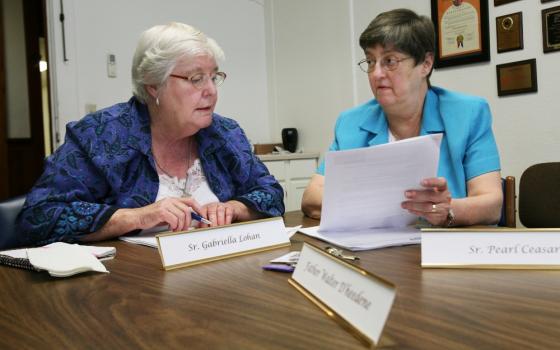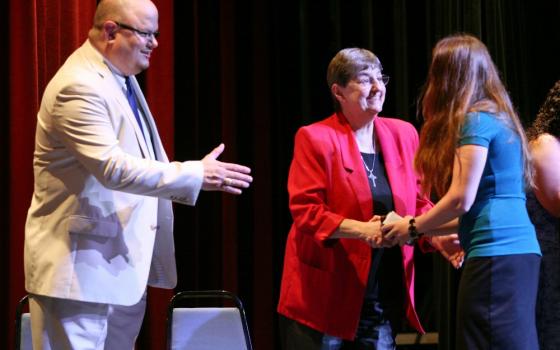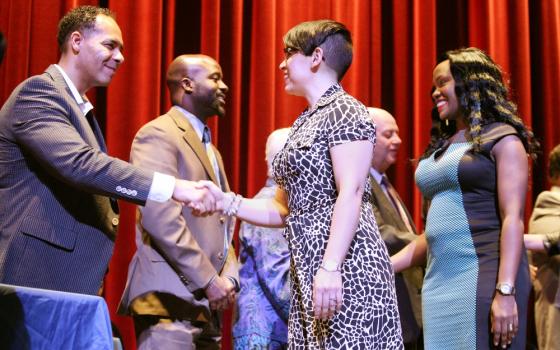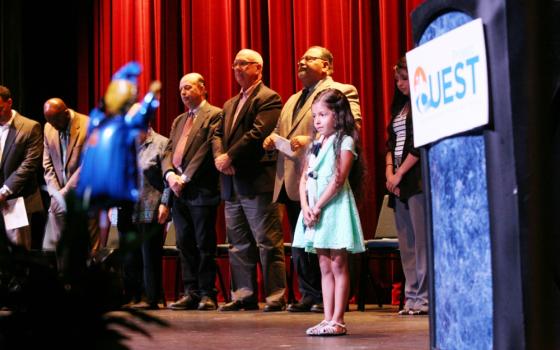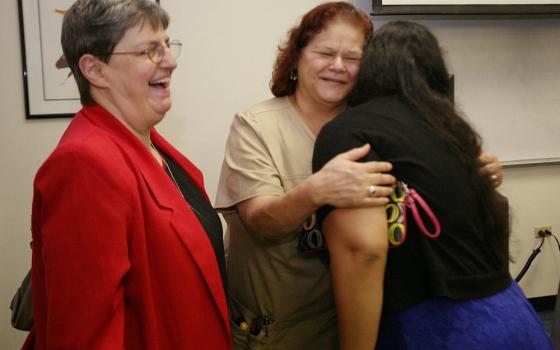The speakers offered words of eloquence and encouragement. Moments later came handshakes, hugs and tears as students crossed the stage. But this was not a typical graduation ceremony. There were no diplomas, no gowns and no hats tossed into the air.
Instead, this ceremony celebrated completion, not from a high school or university, but from job-training programs that varied from associate degrees in nursing to technology certifications. For Erica Espinoza, who went from being a cashier at Bill Miller’s Bar-B-Q to a registered nurse, it opened up a new path, one that leads away from a life of unpaid utility bills, late rent checks, couch surfing and at times, hunger.
“When I crossed the stage, I was really happy. I was smiling; I was shaking every hand,” Espinoza said. “I couldn’t believe I had gotten through everything. It was just pure joy.”
Espinoza was one of 200 students being honored at the graduate recognition ceremony for Project Quest, a labor market intermediary that partners with San Antonio community colleges and local companies offering job-training programs. Its mission: to lead participants like Espinoza out of low-paying jobs and into new, more lucrative careers.
On stage that May evening were Executive Director Pearl Ceasar, a Sister of Divine Providence, and Holy Spirit Sr. Gabriella Lohan, a board member who helped create and implement Project Quest in 1992.
Project Quest was developed and nurtured by these two sisters and other organizers who focused on high-intensity counseling and training for solid jobs that local employers needed to fill. The results have won praise from academics, million-dollar grants and, most recently, an $850,000 gift from the W. K. Kellogg Foundation that was announced at the ceremony.
Underlying it all was the sisters’ drive to improve lives so people can live in dignity.
“People become transformed by being in Quest,” Ceasar said. “Jesus was about the transformation of people and that’s what we do. We are about the transformation of people.”
“It puts a family on the road to security,” said Lohan, who chaired its board for seven years. “My mission is, the charism of the Holy Spirit sisters is, to bring the compassion of Christ to the poor. The compassion of Christ is a decent life; that’s what Jesus wants us to have.”
Project Quest matches applicants with appropriate training programs in 13 fields, including health care and technology. The program covers half the tuition and all of the other costs required for training like fees, books, uniforms and tools. Students pay the remaining tuition, although some qualify for grants or loans, according to Ceasar and Lohan.
The training periods run from eight weeks to two years, depending on the discipline. Students can expect to walk across the stage having completed an associate’s degree or industry certification.
Those degrees or certificates often lead to career paths that significantly increase salaries.
“They come in earning $10,000 a year, and they go out in two years earning $40,000,” Lohan said. “They can afford housing, they can afford transportation . . . they can afford to live in dignity.”
Another registered nurse who benefited from the program was Maria Gutierres, who completed an associate degree program in 2013. Before Project Quest, Gutierres said she made about $15,000 a year as a medical assistant in an ear, nose and throat clinic. After she graduated, she went to work for a home health and hospice agency where she quadrupled her salary.
“This year I got a promotion; they made me hospice director,” Gutierres said, indicating that she had received yet another raise.
Navigating a college education can be challenging, especially for the many Quest students who are the first in their families to go to college.
Gutierres began classes just after her husband was deported to Honduras, leaving her to raise and support her three children.
“My family was not very supportive at all,” she said. “‘How are you going to pay your bills? Who is going to help you?’” they asked. Gutierres turned to friends for help with childcare.
Espinoza, however, faced challenges, too. When she entered college after high school, a counselor signed her up for the maximum number of hours. At that time, her mother was laid off from her job at a hospital, and her family’s house was in foreclosure. Feeling overwhelmed, Espinoza began failing classes and thought she wasn’t “fit” for college. She flunked out.
“I can’t do this, and my house is going to be gone; I don’t know what I’m going to eat tomorrow,” she said. “I was going to college hungry, starving.”
Seven years later Espinoza decided to give higher education another try through Project Quest and its career advisors.
“These are the people I wish I could have met,” she said. “A lot of us haven’t been here before. We haven’t had an older sibling or whatever to be like, ‘We’ve gone to college; this is how you do it.’ They help with so much; they’re so amazing.”
Project Quest’s roots date to 1990, when San Antonio’s Levi Strauss plant closed and more than 1,000 workers, mostly women, lost their jobs. Members of the C.O.P.S.- Metro Alliance, a community service organization, began researching solutions.
Leaders learned that the jobs replacing those at the blue jeans plant were “lower paying jobs like SeaWorld, jobs on the river or tourist jobs that paid minimum wage,” Ceasar said. “Or they were higher-skilled jobs, like jobs at the medical center, health care jobs.’’ Those jobs required training the laid-off workers did not have.
Ceasar, Lohan and other leaders of C.O.P.S.-Metro Alliance met with other organizations and professors at the University of Texas at Austin. The first Quest class enrolled in 1992.
“What was necessary was job training for good jobs that paid a living wage, that had a career path and that paid benefits,” Lohan said. Since its inception, 6,000 people have successfully completed the program according to Ceasar.
While partners provide the training, Quest itself gives students financial and moral support. Every evaluation – and Ceasar said there have been many – reported that “the major, major value added here at Quest was the counseling piece. That’s what makes us different than any other program.”
Oscar Perez, a registered nurse, believes the individual counseling and mandatory weekly VIP meetings with advisors made the difference for him.
“They find out what obstacles we have and they come up with solutions to help us overcome those obstacles. They really are kind of like angels to me.”
At the VIP meetings – short for Vision, Initiative and Persistence – students got tips on goal setting, stress management and financial management.
“That’s where that loyalty and that’s where that admiration for their career advisors comes from,” said Lelani Mercado, director of participant services at Quest, “because if you’re meeting with somebody every single week for two years, you develop a relationship.”
That relationship has kept many students in the program. Marie Ramos’ husband is undocumented and couldn’t work because he didn’t have a Social Security card. So Ramos, a UPS air driver in the nursing program, turned to her counselor, Maria Salazar.
“I ‘d have all these problems like I don’t know what to do; I can’t study; I have to take care of all this paperwork; I have to work; I have my child,” Ramos said. “She [Salazar] would say, ‘Calm down, manage your time,’ and she would help me like that.” Ramos stuck with the program and eventually her husband was able to get a work permit.
For Espinoza, Quest counselors provided an extra dose of confidence. “’You’re so smart, I know you can do this, Erica,’” Espinoza said imitating her advisor after she had failed one course. “I figured out . . . that I have the motivation, I have the brains, I have the work ethic. I just needed someone to believe in me.”
Advisors also help students with gas, food cards and rent assistance to those who qualify. “I couldn’t pay my rent and Project Quest helped me,” Ramos said.
Although the current completion rate is 80 percent, according to Ceasar and Lohan, there are many reasons why 20 percent of students do not finish.
“Mostly it’s financial,” Mercado said. “They have to work; they have to quit school because they just can’t focus on school anymore and they have to go into employment.”
While counselors work to keep students from giving up, without hesitation its leaders say their biggest challenge is fundraising.
“You never know if you’re going to get funding the next year,” Mercado said.
The non-profit organization runs on federal, local, state and private grants, such as the $850,000 Kellogg grant. A Department of Labor grant gave the program $6 million over four years.
In 2011 the non-profit hit a funding crisis. After a state grant was announced, Project Quest started enrolling participants before the contract was signed, “which is not unusual,” Ceasar said.
However, the state changed the enrollment criteria, which meant about 100 participants no longer qualified, Ceasar said.
“It was either tell them to drop out because we don’t have money to support you – or keep them, which the program chose to do,” she said. Quest leaders were confident they could come up with the money later.
“They just couldn’t do it and so they went in debt, $750,000,” Ceasar said. “So that’s when the city came and said, ‘You need to clean up your act.’”
The director of the program resigned and Ceasar took his place. Staff cuts were implemented and an aggressive fundraising campaign took shape. Two days after Ceasar took over, the Department of Labor approved a health care grant that Project Quest had applied for months earlier.
“We firmed up our financial situation,” she said, “and were able to pay back our debts through contributions of friends, allies and again from organizations and religious orders.”
Despite the setbacks, Project Quest has served as a model for programs around the country, including VIDA in Texas’s Rio Grande Valley; JobPath in Tucson, Arizona; Capital Idea in Houston and Austin, and Project ARRIBA in El Paso, Texas. Ceasar said it’s even being modeled in London.
Paul Osterman, a professor in the Sloan School of Management at Massachusetts Institute of Technology, studied Project Quest for a 1996 report. He cited a few findings that made Project Quest stand out.
“Unlike most job training programs and in particular unlike most community college education, the completion rate, the success rate, in Project Quest is very high,” Osterman said.
Completion rates for two-year programs at community colleges range from 26 percent for part-time students to nearly 43 percent of full-time students, according to a report by the American Association of Community Colleges.
Another reason is that Quest “has a very close relationship with employers,” Osterman said, “and so the jobs that it’s training for are jobs that are both in demand, and [that] also provide training on the specific set of skills that employers are looking for.”
Marcus Benavidez is the operations manager for Open Cloud Academy at Rackspace, a local tech company. The academy teaches skills that can help Project Quest students get employment with Rackspace or other companies.
“Quest is very present in what we’re doing here at Open Cloud Academy,” he said. “They’re always a phone call away or an email away and they’re very responsive.”
When a Southwest General Hospital health care recruiter suggested that Quest renew students’ CPR licenses before they completed their program, Quest added that step.
“It’s nice to know that we have a partner that will focus on the candidates. They’ll ask us for feedback,” said Christina Rivera, human resources director for the hospital.
This kind of interaction with employers has also benefitted students like Kevin Johnson who, as a stay-at-home dad for four years, fell behind in his electrical engineering skills. By the time he had finished the 10-week-program at Rackspace’s Open Cloud Academy, he had interviewed with three different tech companies.
“This program,” Johnson said, “puts you right in the face of employers.”
Dressed in hospital scrubs, Rosalinda Espinoza, a patient care assistant, waited in the reception hall after her daughter Erica’s ceremony. The crowd was thinning, but she kept her eye on the door until Ceasar walked in. Rosalinda Espinoza immediately approached her, beaming.
“I’m really thankful for the program and for you all being there for my daughter,” she said, wiping the corner of her eye.
Then the woman recounted how she had always wanted to be a nurse herself and how delighted she was that her daughter was accomplishing her dream. Ceasar suggested she try Quest herself, which made Erica Espinoza laugh.
But Ceasar was adamant that Rosalinda Espinoza could succeed, gave her a business card and encouraged Espinoza to call her.
When Rosalinda Espinoza started work at Santa Rosa hospital 35 years ago, there were no programs like Quest. She worked her way up from the laundry room making $1 an hour to emergency room technician before she was laid off. Eventually she found a job with Metro Methodist Hospital but still harbored dreams of a career as a nurse.
The mother and daughter talked about lost possibilities long after everyone had left the reception and continued the conversation outside at a picnic table after the hall had closed. It was dark and the place had gone silent and still.
“I know for a 100-percent fact if given the opportunity and having that support, she could have been; I know she could have been,” Erica Espinoza said.
And while Ceasar acknowledges that Project Quest “may not be able to change the entire economy,” it may be able to change the “way companies relate to employees and the wages they pay.”
[Nuri Vallbona is a freelance documentary photojournalist. She worked for the Miami Herald from 1993 to 2008 and has been a lecturer at the University of Texas and Texas Tech University.]

